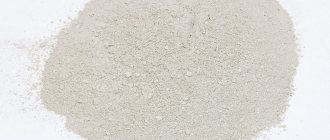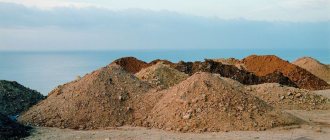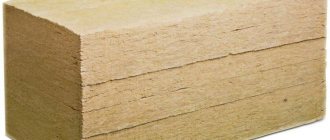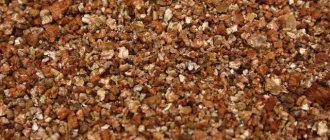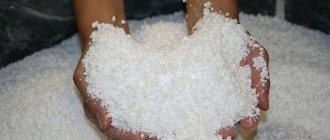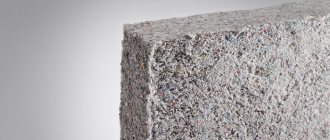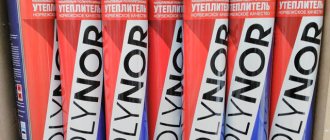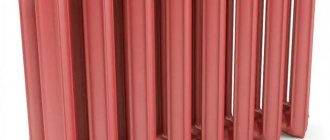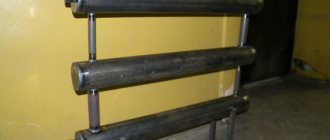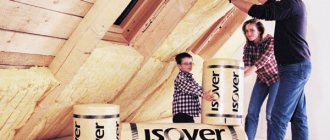Fire clay occupies a key place in the construction industry. With its help, fireplaces and stoves are installed. But the range of uses for fireclay clay is much wider. For example, it is used as plaster. In fact, it is kaolin clay that has undergone heat treatment. For its firing, special furnaces are used, where the temperature is 1500 degrees. At such rates, water evaporates, and the material becomes plastic.
Fireclay fireclay is an extremely important material widely used in construction and decoration.
What it is
Fireclay is a fire-resistant substance obtained from kaolin. The clay is heated to 1.3-1.5 thousand degrees, as a result of which the mass loses moisture and plasticity. During the process, the material sinteres and changes color from gray to brown. The burned pieces are crushed with special metal shafts to the state of fine sand of different fractions.
As a result of temperature changes, clay characteristics are radically transformed. The result is a very strong raw material, with parameters resembling stone. Due to the loss of liquid, the material does not expand when heated, maintaining its strength. After drying, the finished mixture does not shrink or crack.
Fireproof material Source remokna.in.ua
Fireproof fireclay is a semi-finished product for preparing mortar. By adding certain additives it is easy to adjust the parameters and adjust the mass to the needs of a person. You can find out the material in the store by the letter “Ш” on the packaging. The abbreviation “MSh” or “MP” is present in the names of the ready-to-use composition (mortar). The letter “U” is on a pack of a less strong recycled substance (after secondary processing).
Kaolin clay is classified as a material of natural origin. Raw materials are mined from the bottom of seas, lakes or rivers. The appearance and constituent substances often depend on the location of the deposits. The most common is light gray raw material, there are shades of pink, yellow and blue.
Where are raw materials mined Source teplo.guru
Basic rules for preparing the mixture: composition, proportions
In rural conditions, stove makers do not buy ready-made compositions in the store, but prepare them themselves.
The most popular recipe is a clay-sand mortar with the addition of lime and asbestos:
- 2-3 days before use, the clay should be soaked in water. In this case, all floating debris is immediately removed and refilled with clean water.
- It is better to pass the settled clay through a sieve. Stir until smooth.
Even small lumps should not remain in the clay, otherwise this will be the first reason for the formation of cracks in the coating.
- The clay is combined with dry sifted river sand. You can use wet sand, but then you will need more water to mix the solution. The proportion is 1:2, where one part clay goes to two parts sand.
- When adding lime, it is soaked in water overnight.
- The asbestos will need to be fluffed up.
- For one part of clay there is a tenth of asbestos and lime.
To enhance the plasticity of the solution, add 200 g of kitchen salt to the bucket of plaster. This protects well from cracks and guarantees uniform drying of the treated surface.
Another factor that is worth taking into account is how you will have to heat the stove. If the fuel is coal or peat briquettes, which give off intense heat, then it is recommended to add fireclay powder to the mixture. This will increase the resistance of the coating to high thermal loads.
For a wood-burning stove there is no need for such an additive.
Material characteristics
Fireclay clay is produced in powder form, with a fraction of up to 2 mm. If the substance was stored correctly (+15-25 C), then the consistency is homogeneous, without noticeable pieces or lumps. The material loses its properties after 3 years or when kept in damp conditions.
The melting point of all types of fireclay clay is from 1500 to 1850 C. As the degree increases, the performance properties do not change, which allows it to be used in the manufacture of stoves and fireplaces. After sintering, the substance loses its ability to absorb moisture without losing its fire resistance.
Properties of kaolin substance Source proraboff.rf
Kaolin and sand do not have binding capabilities, but when combined, a very strong, dense mass (raw material) is obtained. The strength level of the composition is 12-24 N/sq.mm. Fireclay clay mortar is not inferior in stability to concrete. The product has high adhesive properties, which facilitates subsequent processing.
One package of 20 kg of material is enough to lay 30 bricks. To cover the surface of the cube, use 100 kg of refractory substance. The kaolin composition allows oxygen and moisture to pass through itself, so a favorable microclimate is maintained in the room. Hardened natural fireclay is safe for human health.
Fireclay is a very expensive material with special rules for use. The treated surface takes a long time to dry (3-4 days). If you violate the technology for preparing the solution or do not comply with the exposure time, the mass will not become strong. Fireclay dust rising into the air is toxic, so a respirator with safety glasses is required when mixing ingredients.
Strengths and weaknesses Source yandex.ua
Putty and additional additives
The material can be used for putty. True, there should be a slightly different composition here. Stock up on the necessary materials - take 1 part of Portland cement, 2 parts of fireclay clay and 7 parts of quarry sand. The mixture is mixed in the same way as for laying bricks. Metal mesh is used to fix fireclay plaster.
Materials can be added to the clay solution to enhance the necessary properties.
Additives are used to enhance individual properties of the solution. This is PVA glue, liquid glass or table salt. The latter is used 100 g per bucket of solution. The mass fraction of glass should be no more than 3% of the total quantity. Additives are a good option for improving product performance.
Fireclay clay is absolutely safe, but getting it on your face is still undesirable. In addition, optimal air circulation in the room where work is being carried out should be ensured.
Types of raw materials
Refractory material is the basis from which solutions for various purposes are made. Lump clay is used to create heat-resistant ceramics, bricks and cardboard. The ground type has high characteristics of resistance to fire and strength, which allows it to be used in coating and molding mixtures.
Fireclay is distinguished by the presence of binding additives in its composition. Based on the amount of sand, there are 3 types of raw materials:
- Exhausted. Contains up to 21% of the substance.
- Smooth. The volume of the ingredient varies between 19-48%.
- Binder. Contains 55% loose component.
For a fire-resistant surface, traditional river sand cannot be used in the solution. The substance has a maximum limit of 800 C; at high temperatures it expands, which leads to destruction. Quartz species, kaolin and cement are often used as additives.
Varieties of fireclay clay Source rusboard.net
Stone-like varieties are not used to prepare a solution from fireclay clay. According to the degree of aluminum oxide content, the substance is divided (in percentage) into:
- semi-sour (up to 25);
- basic (26-38);
- highly basic (from 40).
Fireclay powder is divided into 4 grades. Characteristics depend on the degree of fire resistance and the amount of additional ingredients. Numbering from 0 (special) to 3 affects heat resistance and the final cost of the composition.
Surface preparation
Before the main work, the new and old stove should be prepared.
Finishing of a new product can only be done after the final hardening and shrinkage of the masonry mixture. Otherwise, the applied plaster will crack very quickly. In addition, it is important to heat the stove several times, even if this happens in the summer. The walls should warm up well and condensation should disappear. It is recommended to unstitch the seams to a depth of 0.5 cm and brush over the metal. It is worth making notches on the concrete surface (for better adhesion of the plaster to the walls).
If the stove is old, pieces of chipped mortar, plaster, whitewash or paint are removed. If necessary, the walls are cleaned entirely. Cracked bricks are replaced with new ones and re-laid. The remains of the loose solution are swept away with a broom.
In both types of furnaces, soot and soot are removed from the surface, and the ash is cleaned. Oil stains are removed with a degreaser.
Next, use a brush to thoroughly prime the entire surface to be plastered.
Where is it used?
Understanding what fireclay clay is, it is easy to determine the scope of use of raw materials. The powder in solutions is used to create fire-resistant building materials. The substance is used to make strong bricks or clinker tiles. The finish has a high price, so professionals recommend combining it with conventional models.
Using fireclay mortar Source techno-comf.ru
Use Cases
Kaolin can be used for furnace masonry. It is also used as plaster and for making decorative items.
In addition to being used for decorative purposes, chamotte clay is actively used when laying stoves and fireplaces
When building stoves, they look at the markings applied to the surface of the products. Usually the letter "Ш" is indicated. The material most often used is for masonry of the firebox, since its cost is high, so it is impractical to use it for the rest of the work. They lay it on special clay. Its characteristics are the same as those of brick.
Fireclay fireclay has a unique texture and composition
That is why designers paid attention to it and began to use it to produce unique blanks. These can be ceramic dishes, original figurines
To ensure greater plasticity, various impurities are added.
How to use it correctly
The basis of the composition is clay powder and water in the required proportion. During the production of fireclay, kaolin loses its plasticity. To restore the pliability and elasticity of the mixture, special additives are added to the composition. For each task, there are rules that allow you to obtain a strong fire-resistant material.
For laying the furnace
Plasticity indicators are often improved with kaolin sand. The white substance is sold in construction stores in bags. In one container, clay is mixed with the additive in proportions of 4 to 1, then water is slowly poured in small portions. To obtain a uniform consistency, professionals recommend using a special mixer.
In order for the ingredients to reveal their characteristics, the preparation is left for 3 days. The finished mixture resembles plasticine in thickness. The solution should not stick or flow easily, and there should be no lumps under your fingers. If you scoop it up with a trowel, the mass slowly slides off, without leaving a residual mark.
Features of technology for the stove Source stroyfora.ru
The presence of clay components is called fat content. The parameter is responsible for the plasticity of the finished material. You can increase or decrease the characteristic using sand or fireclay. Oversaturated solutions do not affect the quality of the stove, but due to “lean” options, the structure will crumble.
To find out the fat content of clay at home, you need to roll a ball from the finished raw materials. The samples are pressed down on top with a long board. If cracks appeared under low pressure, then the solution is “lean”. If ruptures occur at half the radius of the ball, it indicates high plasticity indicators, and at a third – average (normal). The last two types are suitable for construction work.
The surface to be treated must be prepared. The old finish is removed from the wall and the reinforcing mesh is fixed. In order for the product to hold tightly, a layer of solution must be applied on top. Knowing how long fireclay clay takes to dry, you can begin laying out the stove in 3-4 days.
The classic stove mixture consists of base material and sand. An experienced master uses at least 3 types of solution with different additives when working. Cement-lime varieties are recommended for the base and chimney. When assembling the frame, cement is added to the composition; for the combustion chamber, red clay is added.
Rules for using chamotte Source vbud.in.ua
Methods for decorating a stove
After the plaster layer has dried, you can begin decorating the product. Suitable for this:
- painting or whitewashing;
- tiling;
- applying decorative plaster.
Let's look at each option in more detail.
Painting
Of the purchased paints, only water-based compositions are suitable. Oil-based ones darken quickly and are not resistant to heat. Before you start painting, the surface is thoroughly primed.
Whitewashing is more often practiced. It will be easier to achieve a white surface if lime is added to the plaster.
Old masters diluted one part of chalk with two parts of milk, adding 100 g of kitchen salt to 10 liters of whitewash. Paint is applied in two layers. The composition will not begin to burst and will not smear.
If the owners want to get a finish with a blue tint, then add a little blue to the whitewash. To obtain the desired shade of paint, it can be tinted.
The work is performed with brushes of different sizes.
A good addition would be to apply beautiful textured patterns, colors, and ornaments.
Tile laying
Used for lining fireplaces and stoves.
Material – ceramic, terracotta tiles. Tile is not suitable for such purposes because it cannot withstand constant exposure to high temperatures.
To fasten the elements you will need tile adhesive with heat-resistant properties. Conventional adhesive will not withstand such heat, and the tiles will simply begin to fall off.
Tiles will hide uneven corners. It is enough to glue the finished corner parts.
Pasting is carried out with strict adherence to horizontal and vertical levels. The uniform spacing between the tiles is maintained.
The color and texture of the parts are selected based on the style of the building.
Decorative plaster
The main requirement for decorative plaster is heat resistance.
If this is not available, then you can purchase a mixture for external use, but after plastering, attach gauze around the entire perimeter - this will prevent cracking of the finish.
Acceptable basis of composition:
- mineral (containing lime, clay);
- acrylic;
- silicone;
- silicate;
- heat resistant.
Apply with special spatulas. After drying, it is complemented by painting and varnishing.
How long does fireclay clay take to dry?
Experienced craftsmen say that a large oven can contain a whole barrel of liquid. It is contained in a composition that seals all the seams of the structure and firmly fastens the bricks together into a single reliable thermal system. In order to remove all moisture from a newly built stove and allow the fireclay composition to dry completely, it is necessary not just to wait, but to gradually and slowly heat the stove with a small amount of firewood, thereby helping the moisture to leave the pores of the clay. It is important to observe the ambient temperature - clay contains a large amount of moisture at temperatures below 10 Co, which looks light and dry from the outside.
To drive this moisture out of the composition, you need to maintain the temperature outside the oven in the region of 18-20 Co. You need to heat the stove 2 times a day with a very small amount of firewood - about 4 logs each time. The stove should operate in this mode for approximately 6-10 days (depending on the size of the stove and the depth of the masonry) in the summer and about 2-3 weeks in the winter. Until the structure is completely dry, the stove cannot be used!
In conclusion, it is worth saying that it is absolutely not necessary to resort to the services of experienced stove masons in order to put together a structure for which, in most cases, fireclay clay is used. However, if the homeowner is not sure that he will succeed, and it is a pity to waste material on experiments, then it is better to turn to professionals.
Plaster mortar
To prepare a plaster mortar with your own hands, you will need a pack of dry fireclay clay powder, water, as well as a tall container and a straight stick for stirring the mixture.
Having poured dry fireclay into a special bowl, you need to gradually add water to it until the liquid covers the dry clay. Then the solution is left for at least three days, after which the final mixing begins.
Advantages
The main advantages of chamotte include the following:
- thermal stability;
- vapor permeability: the solution absorbs, retains and returns moisture vapor well;
- durability: the material retains its original appearance for a long time without cracks or shedding;
- adhesion ability: bonds well to any type of surface;
- high environmental friendliness and safety;
- low cost compared to other building materials.
When purchasing fireclay clay, you need to make sure that it has been stored correctly. The technical characteristics of this material are negatively affected by humid air.
In addition, it is worth paying attention to the expiration date: over time, the material loses its production qualities. Purchased calcined kaolin can be stored in its original packaging for two years.
